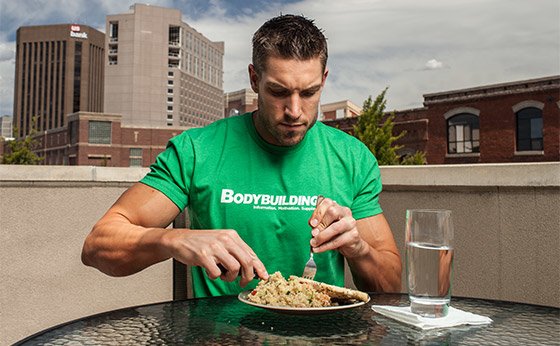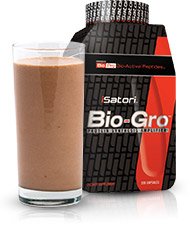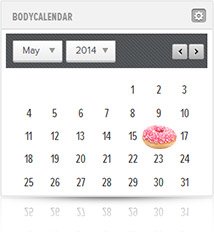"To be or not to be," said Shakespeare's despondent Prince Hamlet, an admission that we often face painful choices in life. "To transform or not to transform" might not have the same ring to it, but it is a choice, and not always an easy one to make. If you're out of shape, staying that way lowers your quality of life and poses health risks. But transforming takes great, sustained effort.
Of course, you need to train right and eat smart to transform. But that's not all, not by a long shot. To successfully transform, you need to work at it. Yes, respect the body, but push it at every chance you get. When you hurt the most, when your mind is drained, these are the moments when you must persevere. Only then will you transform.
This article offers 10 ways to crank up your transformation for maximum effect. Follow these proven tips and efficient practices and you'll spark a transformation that would leave the Bard himself at a loss for words. Here we go!
Respect Recovery
I list this first because rest—between exercise sessions and sleep—is perhaps the most underrated component of your transformation. People think that going 100 miles per hour, feeling the burn, and pushing themselves day after day helps make their body stronger faster. In a sense, the body does get smarter and learns to adapt to your recklessness, but it's a trap!
Muscles grow when your body is at rest, so you truly must rest. Your rituals outside the gym can influence overall growth and improvements. Hard lifting and physical exertion stress the body out. Nutritional intervention can help mitigate the damage and support your efforts, but even perfect nutrition isn't enough to undo all the exercise-induced microtears and pro-inflammatory processes of the active, modern life.
Make your 7-9 hours of sleep per night a priority. Make an effort to rest on your off days.
Eat to Lose
Dropping your body fat doesn't mean starving yourself; you'll still want to consume plenty of calories to fuel energy needs and hold onto hard-earned muscle tissue. While you will reduce carbohydrate intake on such strict diets, consuming adequate amounts of protein becomes even more critical when dieting.
Slightly increasing your protein intake—get about 40 grams at each meal or snack—will help limit the catabolic effects of following a fat-burning diet on muscle tissue.

Track Your Progress
Take an honest and realistic look at yourself in the mirror. Don't be afraid to flex or pinch, and don't hesitate to compliment yourself on aspects of your body that you may like. Nor should you give yourself undeserved compliments. This is reality-check time, folks.
Snap a picture! It will show you how others see you. There's a net positive effect about the much-scorned practice of taking "selfies." Bodybuilding.com's Strength in Numbers study shows that people who post progress pictures along their journey tended to fare much better in the long run than people who do not. Plus, it's cool to see yourself looking stronger and inching closer toward your ideal physique in slideshow fashion.
In addition to progress photos, you should record your weight, body fat, and certain body measurements (like waist) every four weeks. This hard data will assuredly tell you that your hard work bears fruit. Measurable changes will motivate you to keep going. Tracking serves as a sort of barometer for how your training and diet are working for you.
Fuel Your Workouts

Pre- and post-workout meals and supplements provide the energy necessary to make your workouts more productive and to enhance recovery and performance. Other than a meal composed of whole foods, supplements like branched-chain amino acids, essential amino acids, protein powders, and a new category of supplements called Bio-Active Peptides (BAPs, for short), such as those found in iSatori's Bio-Gro, can promote muscle growth.
The next time your tank runs low, try adding Bio-Gro to your protein shake to give your body every advantage it can get in the drive to synthesize new muscle.
Keep the pace in the gym
When you are in the weight room, be in the weight room. Adhere to the rest periods set out in your program. Don't be slowed by gym chatter, crowded facilities, or cell-phone distractions. Keep the pace. Move through your workout in a controlled manner.
Get serious about your training. Focus on the exercises in front of you.
Keep a little consistency and discipline as you allow yourself time to recover between sets and exercises. Don't rest for one minute on one set, then get distracted by your phone for five minutes before you hit the next. These breaks in the pace of a workout will keep you from progressing. Every wasted second in the weight room shows up later in your physique.

Assess Your Progress Frequently, But Not Obsessively
It takes as long as 48-72 hours for your body to "catch up" from training stimuli and diet interventions, so expecting your body to change daily and "panic correcting" will only set you up for disappointment.
Your weight will fluctuate daily due to a number of factors, including water weight, bowel movements, and time of the day. Stay the course, don't obsess over every day-to-day detail, and re-assess in a week or two.
Plan Your Cheats Meals

For nutrition newbies and competitors alike, cheat meals help the mind more so than they do the body. Of course, if you take into account the effects of the occasional, controlled "refeed" on hunger-regulating hormones during a hypocaloric diet, cheat meals certainly help the body, too—although that's a discussion for another day.
To keep yourself from temporarily going off your rocker and succumbing to the slightest temptation, plan ahead for cheat meals or events where you cannot control every parameter of your food intake.
For example, you don't want to show up to a wedding with a tote bag full of Tupperware, but you may want to establish and adhere to boundaries—such as limiting yourself to large quantities of only three kinds of food.
Weights Before Cardio
If you are ever forced to choose between weight training and cardio, always opt for weight training. The act of lifting weights elicits the most positive effect on your transformation. Cardio is clearly helpful to a transformation, but not as much as weight training.
Throw in 1-2 sessions of high-intensity interval training (HIIT) every week to accelerate your transformation. HIIT has been shown to support fat loss, but it is also the most taxing for your central nervous system. Don't overdo it to the point that it starts to hinder your weight training efforts at the gym. Steady-state cardio has been shown to promote deeper and more restful sleep and improved recovery.
There is a place for both in a training program. If your goal is fat loss, HIIT can expedite the process. If you have a poor aerobic base and would like to build it, steady-state cardio is the way to go. But, again, weight sessions should come first.

Respect Rest
Give your body ample time to recover both in between sets and out of the gym. Don't train sore muscles or push yourself until you drop to your knees. As your transformation moves forward, you'll start to get a feel for what your body needs. You will find that after a day off your body will be stronger and your workout will improve. You will notice a difference in intensity between 30-second rests and 90-second rests. The new transformer tends to be zealous, experiments with a variety of training modalities and pushes him or herself to oblivion with eight workouts every week, three hours every day. This rush to fitness wears you out.
The parable about the tortoise and hare is a good one to bring up: Slow and steady wins the race. If you push too hard, you'll be exhausted before you reach the finish line.

Taking on too much volume can be detrimental to your body, cut into recovery and disrupt your hormone balance. If you find you aren't able to adequately recover between workouts or experience poor sleep quality, consider trimming volume from your program somewhere.
Tell Yourself You Can Do It
Transformations are a slow-burn process: Workouts don't get any easier and motivation comes and goes.
You will inevitably hit a brick wall during your journey, but a positive mindset goes a long way in helping you achieve lofty, long-term goals.
Your pursuits lead you to healthier living and will be contagious to everyone around you. Take the challenge and never tell yourself something can't be done without trying.
Change your body and life for the better, and you will never look back at where you once stood!

Recommended For You

7 Traits Of Successful Physical Transformations
Success, they say, leaves behind clues. If you want to make this year the year you finally get it right, learn from people who have achieved life-altering transformations before you!
Transform With Muscle: Why Focusing On Fat Loss Isn't The Answer
Don't get so wrapped up in losing fat that you forget about muscle. It's the real key to a successful, lasting transformation!

